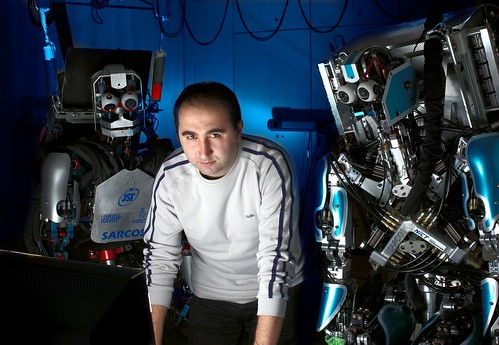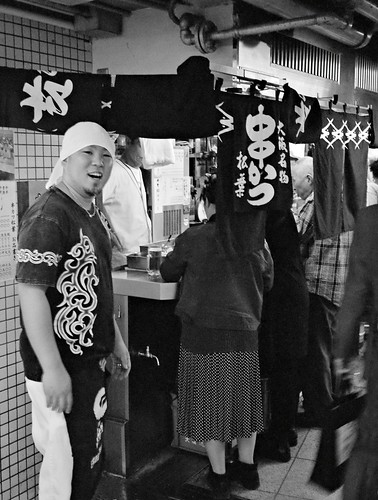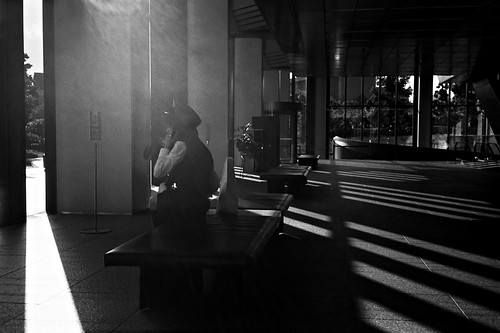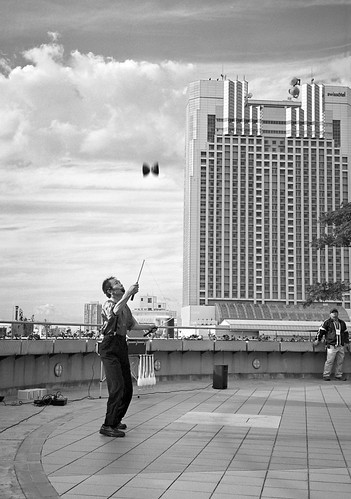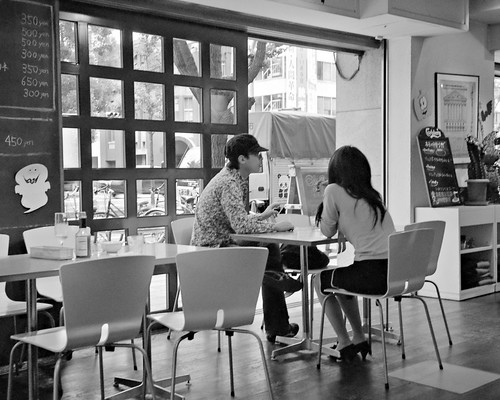Off-topic and of somewhat dubious veracity, but if it's true it's too cool not to share: It seems that the son of a certain Michael Young inherited a substantial sum of money from his father. The father was an old-time bigot, a mean-spiritedly religious misanthrope and heartily disliked by his son.
So now the son is donating his fathers money, in small sums, to any and all causes opposing everything his father stood for: Revenge is sweet
Saturday, November 28, 2009
Thursday, November 26, 2009
Japan Reviews its Projects
The new DPJ government is holding a review of government-financed projects. The aim is to cut wasteful spending to shrink the deficit and release money for other, better uses. The fun thing is, the review is in public, and televised. Basically, each of the selected projects (they only review about 10% of all projects this round) gets an hour or so to explain themselves and be questioned by a panel tasked with evaluating them. At the end the panel votes their recommendation (so far almost always reducing or cutting projects altogether). Shisaku has an excellent writeup here.
The idea and process is basically sound, if rather hurried. The problem is that the evaluation is really fiscal in nature - does this project pay for itself or not - and doesn't take other factors fully into account. This really should be the first step in a two-step process: First evaluate the direct fiscal value of projects. Then evaluate the larger political/societal consequences too.
The fiscal value of military defence, for instance, is probably dubious for many countries. It's a very expensive system preventing very rare threats. It may simply not be cost-effective to prevent a once-per-century invasion. A small police force-like coast guard and a professional rescue corps could do most or all that an army does in peace-time at a fraction of the cost, while a bit of the savings could be used to pay off would-be invaders, or rent an army short-term from a friendly country when needed. Ridiculous? Of course. There's value in a national defence force beyond the direct fiscal balance in the perceived safety and stability.
A modern country - that "information society" thing - lives and dies by the skill of its people. That skill is more often than not imparted through higher education. Educators at that level are normally required to have a research degree - a doctorate - and are often also required to do some amount of research along with their teaching. Why is that? It's because doing research is the only way to become intimately familiar with a field, familiar enough that you understand where the field is going, and can decide what to teach, not just how. So you need people with research experience to teach at your universities and colleges. Medical doctors need research experience too, and company labs need young researchers to staff them.
But that means you have to offer ways for students to become researchers. You can't become a scientist just by studying - you need to actually work in real research projects. And the current teachers are also researchers, remember, and need to do research along with their teaching. Not to mention that they're researchers because they find it fun and rewarding. Scientists as a group are very mobile - a couple of colleagues of mine have worked in six countries this past ten years - and if you remove their ability to do research, including "useless" but interesting projects, many will simply pull up their tent pegs and leave.
So you do need enough research funding to support the research activities of university faculty and graduate students, or you're going to find ourself without good quality higher education in the field. Which will soon mean you'll find yourself without many of your brighter young people as they leave for better training abroad, and frequently not coming back.
"OK", you say, "so fund applied science, things we can use. Skip the abstract stuff." But applied and basic research isn't really separable. Applied research feeds on the advances in fundamental science, and theoretical science is often guided by the needs of applied scientists. Many research projects employ people from both ends of the spectrum and researchers themselves sometimes drift back and forth over time.
Look at mathematics, which at the research level may seem hopelessly abstract and useless. But it's long been tightly coupled to physics and has evolved as a tool in response to the needs of physicists. More recently the information sciences have also influenced the development of mathematics, and benefit from it in turn.
So if you want graduates skilled in a particular field you do need to support both applied and basic research, and enough of it to sustain a community of researchers. And it will mean supporting high-risk as well as low-risk projects and enduring a fair number of disappointments and outright failures. Research projects do in other words have a value beyond the immediate cost-benefit calculations, and projects that support other research in turn even more so.
The idea and process is basically sound, if rather hurried. The problem is that the evaluation is really fiscal in nature - does this project pay for itself or not - and doesn't take other factors fully into account. This really should be the first step in a two-step process: First evaluate the direct fiscal value of projects. Then evaluate the larger political/societal consequences too.
The fiscal value of military defence, for instance, is probably dubious for many countries. It's a very expensive system preventing very rare threats. It may simply not be cost-effective to prevent a once-per-century invasion. A small police force-like coast guard and a professional rescue corps could do most or all that an army does in peace-time at a fraction of the cost, while a bit of the savings could be used to pay off would-be invaders, or rent an army short-term from a friendly country when needed. Ridiculous? Of course. There's value in a national defence force beyond the direct fiscal balance in the perceived safety and stability.
Most scientific research is probably wasteful from a direct cost-benefit perspective. Research projects generally have little impact on society; even most medical research have only the most tenuous, indirect effect on the well-being of people. The very nature of research means it's normal and common for projects to fail. Scientists themselves are happy to admit their projects are often motivated by personal curiosity.
We could keep just the few projects with direct societal impact and quick pay-off and stop funding basic research, long-term projects or anything highly risky. That is absolutely an option, and if you're in financial crisis and you have to choose, science is certainly not as important as, say, functioning emergency services or health care. And no matter how well off, no society can afford to finance research in everyarea. You need to choose. But to choose wisely you need to know the consequences of your choice.
So, what are the consequences of not doing research in a particular field? We'd not lose the knowledge - the research would mostly still be done somewhere - but lose the ability to use it.
We could keep just the few projects with direct societal impact and quick pay-off and stop funding basic research, long-term projects or anything highly risky. That is absolutely an option, and if you're in financial crisis and you have to choose, science is certainly not as important as, say, functioning emergency services or health care. And no matter how well off, no society can afford to finance research in everyarea. You need to choose. But to choose wisely you need to know the consequences of your choice.
So, what are the consequences of not doing research in a particular field? We'd not lose the knowledge - the research would mostly still be done somewhere - but lose the ability to use it.
A modern country - that "information society" thing - lives and dies by the skill of its people. That skill is more often than not imparted through higher education. Educators at that level are normally required to have a research degree - a doctorate - and are often also required to do some amount of research along with their teaching. Why is that? It's because doing research is the only way to become intimately familiar with a field, familiar enough that you understand where the field is going, and can decide what to teach, not just how. So you need people with research experience to teach at your universities and colleges. Medical doctors need research experience too, and company labs need young researchers to staff them.
But that means you have to offer ways for students to become researchers. You can't become a scientist just by studying - you need to actually work in real research projects. And the current teachers are also researchers, remember, and need to do research along with their teaching. Not to mention that they're researchers because they find it fun and rewarding. Scientists as a group are very mobile - a couple of colleagues of mine have worked in six countries this past ten years - and if you remove their ability to do research, including "useless" but interesting projects, many will simply pull up their tent pegs and leave.
So you do need enough research funding to support the research activities of university faculty and graduate students, or you're going to find ourself without good quality higher education in the field. Which will soon mean you'll find yourself without many of your brighter young people as they leave for better training abroad, and frequently not coming back.
"OK", you say, "so fund applied science, things we can use. Skip the abstract stuff." But applied and basic research isn't really separable. Applied research feeds on the advances in fundamental science, and theoretical science is often guided by the needs of applied scientists. Many research projects employ people from both ends of the spectrum and researchers themselves sometimes drift back and forth over time.
Look at mathematics, which at the research level may seem hopelessly abstract and useless. But it's long been tightly coupled to physics and has evolved as a tool in response to the needs of physicists. More recently the information sciences have also influenced the development of mathematics, and benefit from it in turn.
So if you want graduates skilled in a particular field you do need to support both applied and basic research, and enough of it to sustain a community of researchers. And it will mean supporting high-risk as well as low-risk projects and enduring a fair number of disappointments and outright failures. Research projects do in other words have a value beyond the immediate cost-benefit calculations, and projects that support other research in turn even more so.
Tuesday, November 24, 2009
Wako Business
I'm off to Wako-shi northwest of Tokyo. Wako is not called "The Pearl of Saitama", the birthplace of no celebrities of note and not the site of a fondly remembered romantic drama from the 1950's that now doesn't draw hordes of visitors eager to walk the same cobblestoned streets as the young couple in the movie, on account of no such movie existing.
Its claim to fame, relatively speaking, is instead the Riken institute headquarters. The research project I'm a small part of is financed through Riken, so it's a natural place for us to hold project meetings. It's far enough that I can't get there the same day; instead I leave this afternoon, stay in illustrious Ikebukuro and take the train out to Wako tomorrow morning. I can just make the last Shinkansen to Osaka tomorrow, which gets me to my front door right about half past midnight. Pretty OK.
If that maglev between Tokyo and Osaka ever becomes reality I'd be able to make this a day trip - more likely I'm already retired by then of course.
Its claim to fame, relatively speaking, is instead the Riken institute headquarters. The research project I'm a small part of is financed through Riken, so it's a natural place for us to hold project meetings. It's far enough that I can't get there the same day; instead I leave this afternoon, stay in illustrious Ikebukuro and take the train out to Wako tomorrow morning. I can just make the last Shinkansen to Osaka tomorrow, which gets me to my front door right about half past midnight. Pretty OK.
If that maglev between Tokyo and Osaka ever becomes reality I'd be able to make this a day trip - more likely I'm already retired by then of course.
Wednesday, November 18, 2009
The Rice Cooker Is Dead
Our rice cooker broke the other day. The magic smoke has escaped; it's gone, passed away, pushing up the daisies, taken down the sign, wearing a wooden overcoat. Bereft of life, it's gone to meet its maker. It is an ex- ... you get the idea.
When I first came here I was just a little bewildered over the rice cooker. Sure, people eat rice everyday, but why have a separate machine taking up space in the small kitchen just to cook something? I used to eat pasta almost every day (and had the waistline to prove it), but I never felt a need for a pasta cooker or anything.
Pasta or potatoes are simply boiled until done. But rice is rinsed, soaked for half an hour or more, then slow cooked until dry. It's a slower process, where you need to measure rice and water precisely, wait for it to soak, then monitor the cooking pot so it doesn't burn. It's a hassle, it keeps you around the kitchen for almost an hour, and if you forget the pot you'll eat burnt, crunchy rice, and perhaps even get to explain the wailing smoke alarms and the black, smoldering pot on the balcony to the frowning fireman standing at your door.
With a rice cooker you never burn your rice. They run the cooking process without any help. You can fill the cooker with rice and water in the morning, set the timer, go to work, and have soft, fluffy rice waiting when you get home at night. They can keep the finished rice warm and soft for hours and hours, so it doesn't matter if you end up eating much later than you thought. And they're insulated so they're more energy efficient than a stove - and they don't heat up the kitchen in the hot summer.
Our stove has a rice-cooking function that monitors the temperature and turns off the gas when the water runs out in the pot. This works fairly well, actually, and has given us some time to shop around for a new rice cooker. And we've needed it - it's amazing just how many variations there are on this simple theme. From basic rice cookers for a couple thousand yen or so, up to SuperUltraDeluxe models in the nosebleed-inducing 70000-80000 yen range.
They all do much the same thing of course. It's basically an enclosed metal pot with a heater and temperature sensor in the bottom and a tight lid with a pressure valve at the top. Put rice and water in it and press the button. It will let the rice soak, then heat it until it slow boils. When the water is absorbed the temperature starts rising in the bottom, and the cooker cuts the heater temperature until it just keeps the rice warm. The remaining steam in the pot can't escape through the tight lid so it keeps the rice moist and soft.
As you move up in price you get better brands, larger capacity, induction heating (apparently improves on the keeping time and energy use), non-stick and copper pots, better design, steamer function and so on. Seems that paying much more than 15-20k yen won't really get you any better functionality or quality though. We'll see, but we have to get one soon - they're too convenient to go without.
When I first came here I was just a little bewildered over the rice cooker. Sure, people eat rice everyday, but why have a separate machine taking up space in the small kitchen just to cook something? I used to eat pasta almost every day (and had the waistline to prove it), but I never felt a need for a pasta cooker or anything.
Pasta or potatoes are simply boiled until done. But rice is rinsed, soaked for half an hour or more, then slow cooked until dry. It's a slower process, where you need to measure rice and water precisely, wait for it to soak, then monitor the cooking pot so it doesn't burn. It's a hassle, it keeps you around the kitchen for almost an hour, and if you forget the pot you'll eat burnt, crunchy rice, and perhaps even get to explain the wailing smoke alarms and the black, smoldering pot on the balcony to the frowning fireman standing at your door.
With a rice cooker you never burn your rice. They run the cooking process without any help. You can fill the cooker with rice and water in the morning, set the timer, go to work, and have soft, fluffy rice waiting when you get home at night. They can keep the finished rice warm and soft for hours and hours, so it doesn't matter if you end up eating much later than you thought. And they're insulated so they're more energy efficient than a stove - and they don't heat up the kitchen in the hot summer.
Our stove has a rice-cooking function that monitors the temperature and turns off the gas when the water runs out in the pot. This works fairly well, actually, and has given us some time to shop around for a new rice cooker. And we've needed it - it's amazing just how many variations there are on this simple theme. From basic rice cookers for a couple thousand yen or so, up to SuperUltraDeluxe models in the nosebleed-inducing 70000-80000 yen range.
They all do much the same thing of course. It's basically an enclosed metal pot with a heater and temperature sensor in the bottom and a tight lid with a pressure valve at the top. Put rice and water in it and press the button. It will let the rice soak, then heat it until it slow boils. When the water is absorbed the temperature starts rising in the bottom, and the cooker cuts the heater temperature until it just keeps the rice warm. The remaining steam in the pot can't escape through the tight lid so it keeps the rice moist and soft.
As you move up in price you get better brands, larger capacity, induction heating (apparently improves on the keeping time and energy use), non-stick and copper pots, better design, steamer function and so on. Seems that paying much more than 15-20k yen won't really get you any better functionality or quality though. We'll see, but we have to get one soon - they're too convenient to go without.
Monday, November 16, 2009
Osaka Black and White
I'm a little preoccupied at the moment; the winds of change are sweeping through the economic and political landscape, and buffeting my little corner of it as well. Also, the JLPT Japanese test is held again in less than three weeks or so, and while I don't plan to pass it this year either I still want to prepare a bit. I don't really have the time or the inclination to write any long, substantial posts right now, in other words. But I don't want to go silent either, so in place of anything substantial I'll do some shorter fluff pieces instead.
First, let's do a classic - let's do a picture post!
It's autumn, and the farmers are busy preparing for winter. This woman was digging up part of her rice field - it turns out that soil tends to pile up around the field water drains, so she was moving the excess over to the vegetable garden.
In the Umeda underground, near the Hanshin railways side, you find this counter-only kushikatsu diner. I love the atmosphere, and I keep wanting to eat here but since we're always on the way to eat somewhere else we never get the chance.
Nakanoshima island between Umeda and Namba, from one of the bridges over Okawa. I like the film noir-like atmosphere.
Why is it so grainy? It's 35mm film, and I accidentally underexposed it two or three stops. Push the brightness back up and you get lots of grain.
The lobby of Crystal Tower, one of the highrises north of Osaka castle. There's a café on the bottom floor, but the building is really still and quiet on a Sunday afternoon.
A juggler is entertaining people on the roof of Namba Parks shopping center. This was a few weeks ago; the weather wouldn't really permit this today.
A café around Nishiohashi. This area is kind of hip: there's plenty of cafés and italian-style restaurants; clothing and second-hand stores; art, music and design schools; bicycle makers (if you're a hipster and need a fixie, this is the place), guitar shops and so on. Everything you need to be an offbeat and spontaneous 20-something with an artistic, deep, sensitive side you can pick up right in the neighbourhood.
It's also where our closest large supermarket is, so we get to go wander around this area quite a lot. The atmosphere is relaxed and the shops are fun to watch.
First, let's do a classic - let's do a picture post!
It's autumn, and the farmers are busy preparing for winter. This woman was digging up part of her rice field - it turns out that soil tends to pile up around the field water drains, so she was moving the excess over to the vegetable garden.
In the Umeda underground, near the Hanshin railways side, you find this counter-only kushikatsu diner. I love the atmosphere, and I keep wanting to eat here but since we're always on the way to eat somewhere else we never get the chance.
Nakanoshima island between Umeda and Namba, from one of the bridges over Okawa. I like the film noir-like atmosphere.
Why is it so grainy? It's 35mm film, and I accidentally underexposed it two or three stops. Push the brightness back up and you get lots of grain.
The lobby of Crystal Tower, one of the highrises north of Osaka castle. There's a café on the bottom floor, but the building is really still and quiet on a Sunday afternoon.
A juggler is entertaining people on the roof of Namba Parks shopping center. This was a few weeks ago; the weather wouldn't really permit this today.
A café around Nishiohashi. This area is kind of hip: there's plenty of cafés and italian-style restaurants; clothing and second-hand stores; art, music and design schools; bicycle makers (if you're a hipster and need a fixie, this is the place), guitar shops and so on. Everything you need to be an offbeat and spontaneous 20-something with an artistic, deep, sensitive side you can pick up right in the neighbourhood.
It's also where our closest large supermarket is, so we get to go wander around this area quite a lot. The atmosphere is relaxed and the shops are fun to watch.
Wednesday, November 11, 2009
Smoke Detector Stats
Busy, busy, but I have to take up an obvious piece of faulty reasoning here. An opinionator in the Swedish daily paper Dagens Nyheter by the name of Malin Siwe has a short piece arguing against excessive safety regulations. It's not really unusually bad; indeed, that's my problem with it. This is rather typical for newspaper opinion pieces, in fact.
She is trying to make a perfectly good point: when safety rules become too numerous and too detailed, people end up trying to comply with the rules rather than actually improving safety. The problem with the piece is that her main example is an argument in favour of more rules, not against it. And her lack of statistical understanding means she is completely oblivious to that fact. Here's the relevant passages (roughly translated, emphases mine):
She's arguing that smoke detectors don't help, and that a law mandating them everywhere wouldn't do any good. But she is innumerate enough that her example is actually arguing against her position. Now, can anybody spot the problem above? The information in bold is enough to figure it out.
90% of homes have smoke detectors and 10% do not. Now, if smoke detectors really were useless, then 90% of the fatal fires would also happen in smoke detector-equipped homes while 10% would happen in detector-less ones. But they don't. As she says, a "large minority" of fatal cases happened when a smoke detector was present. Even with a generous interpretation of "large minority", less than half of fatal fires happened when there was a smoke detector in the home.
Let's be very generous, in fact, and say that half - 50% - of fatal fires happened in homes with smoke detectors. In that case, you're nine times less likely to die if you have a smoke detector than if you don't. If "large minority had smoke detectors" actually is something like a third then the number is closer to 20 times. That, to me, is some very persuasive data in favour of mandating smoke detectors.
I don't have a background in statistics1. I suck at this kind of reasoning, so I always need to draw a figure or two to really understand what is going on. Just to make it clear, take a look at the figures below:

The total area of the rectangle above is all the homes, smoke detector or not. The blue part - 90% - is the homes with a smoke detector. The small orange part at 10% are the homes without. We want to figure out how much more likely you are to have a fatal fire if you're in a home without a smoke detector.
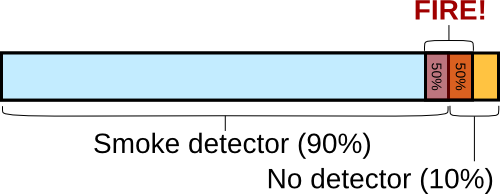
Now we add the fires; that's the small rectangle straddling the two home areas. We don't know how many fires there are compared to the overall number of homes, but it doesn't matter. We're only interested in the difference in risk between smoke detector and detector-less homes.
We were generous above, and said that half the fires where in homes with smoke detectors. So half of the "fire" area is on the "smoke detector" side, and half on the "no detector" side. Again, the size of the "fire" area depends on how many fires there are, but the proportions don't change.
Now, note that the "fire"-part is a much bigger part of the "no detector" area than it is of the "smoke detector" area. That is the point - a much larger proportion of no-detector homes will have a fire than the proportion of smoke detector ones. You're much more likely to have a fatal fire without a smoke detector than when you do.
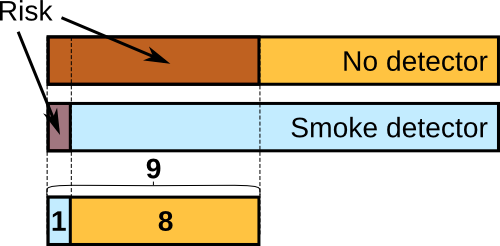
Let's make it clearer still: Here's the "no detector" area at the top, and the "smoke detector" area at the bottom. We've scaled them so we can compare them directly. Again, the "fire" area - the risk of having a fatal fire - is much larger for the detector-less homes than for those with a detector.
How large the risk is depends on the total number of homes and the number of fatal fires. But the difference in risk depends only on the proportion of smoke detectors, and the proportion of fires in those homes. With our numbers - 90% of homes have smoke detectors, and have 50% of the fires - it turns out you're nine times more likely to have a fatal fire when you don't have a detector than when you do.
Now, she points out that only some smoke detectors actually work. True enough - but that means a larger proportion of fires should be counted among households without smoke detectors too, and becomes an argument in favour of mandating smoke detectors and periodic checks, rather than against. Even with the most pessimistic estimate of working smoke detectors, you're still a couple of times more likely to avoid a fatal fire when you have one in your home2.
For those who can't read Swedish she also has a rather confused line of argument around the total number of fatal fires, but it's so incomplete and specious that the only thing it shows is that she doesn't understand high-school level statistics.
Now, I don't blame her. She's not good with statistics - but then, most people are not. Nobody is good at everything. Where she goes wrong is not in misunderstanding statistics; it's in not asking somebody who does understand it for feedback and help.
This is why I despair over the future of the newspaper. After all, the defining difference between professionally staffed newspapers and bloggers is supposed to be that newspapers have the time, the resources and the know-how to check original sources, ask experts for second opinions, fact-check every word and edit the finished text. This opinion piece could have been sanity-checked in ten minutes by anybody with a basic mathematical background. No need to even go outside; somebody from the newspaper's Accounting or IT department would have enough math background to catch the faulty reasoning.
But it wasn't fact checked. As it is, the columnist has publisheda blog post an opinion piece arguing against the (otherwise quite reasonable) standpoint it was meant to support. When newspaper opinion and editorials ends up reading like second-rate blog posts, I'd rather just skip the papers and read first-rate posts on the net instead.
She is trying to make a perfectly good point: when safety rules become too numerous and too detailed, people end up trying to comply with the rules rather than actually improving safety. The problem with the piece is that her main example is an argument in favour of more rules, not against it. And her lack of statistical understanding means she is completely oblivious to that fact. Here's the relevant passages (roughly translated, emphases mine):
All apartment buildings built since 1999 must have smoke detectors. Many local governments rule that all homes must have them installed. Nine out of ten households have such smoke detectors today.
...
Most cases [of deadly home fires] lacked a smoke detector, but they were there in a large minority of cases - and some worked.
She's arguing that smoke detectors don't help, and that a law mandating them everywhere wouldn't do any good. But she is innumerate enough that her example is actually arguing against her position. Now, can anybody spot the problem above? The information in bold is enough to figure it out.
90% of homes have smoke detectors and 10% do not. Now, if smoke detectors really were useless, then 90% of the fatal fires would also happen in smoke detector-equipped homes while 10% would happen in detector-less ones. But they don't. As she says, a "large minority" of fatal cases happened when a smoke detector was present. Even with a generous interpretation of "large minority", less than half of fatal fires happened when there was a smoke detector in the home.
Let's be very generous, in fact, and say that half - 50% - of fatal fires happened in homes with smoke detectors. In that case, you're nine times less likely to die if you have a smoke detector than if you don't. If "large minority had smoke detectors" actually is something like a third then the number is closer to 20 times. That, to me, is some very persuasive data in favour of mandating smoke detectors.
I don't have a background in statistics1. I suck at this kind of reasoning, so I always need to draw a figure or two to really understand what is going on. Just to make it clear, take a look at the figures below:

The total area of the rectangle above is all the homes, smoke detector or not. The blue part - 90% - is the homes with a smoke detector. The small orange part at 10% are the homes without. We want to figure out how much more likely you are to have a fatal fire if you're in a home without a smoke detector.

Now we add the fires; that's the small rectangle straddling the two home areas. We don't know how many fires there are compared to the overall number of homes, but it doesn't matter. We're only interested in the difference in risk between smoke detector and detector-less homes.
We were generous above, and said that half the fires where in homes with smoke detectors. So half of the "fire" area is on the "smoke detector" side, and half on the "no detector" side. Again, the size of the "fire" area depends on how many fires there are, but the proportions don't change.
Now, note that the "fire"-part is a much bigger part of the "no detector" area than it is of the "smoke detector" area. That is the point - a much larger proportion of no-detector homes will have a fire than the proportion of smoke detector ones. You're much more likely to have a fatal fire without a smoke detector than when you do.

Let's make it clearer still: Here's the "no detector" area at the top, and the "smoke detector" area at the bottom. We've scaled them so we can compare them directly. Again, the "fire" area - the risk of having a fatal fire - is much larger for the detector-less homes than for those with a detector.
How large the risk is depends on the total number of homes and the number of fatal fires. But the difference in risk depends only on the proportion of smoke detectors, and the proportion of fires in those homes. With our numbers - 90% of homes have smoke detectors, and have 50% of the fires - it turns out you're nine times more likely to have a fatal fire when you don't have a detector than when you do.
Now, she points out that only some smoke detectors actually work. True enough - but that means a larger proportion of fires should be counted among households without smoke detectors too, and becomes an argument in favour of mandating smoke detectors and periodic checks, rather than against. Even with the most pessimistic estimate of working smoke detectors, you're still a couple of times more likely to avoid a fatal fire when you have one in your home2.
For those who can't read Swedish she also has a rather confused line of argument around the total number of fatal fires, but it's so incomplete and specious that the only thing it shows is that she doesn't understand high-school level statistics.
Now, I don't blame her. She's not good with statistics - but then, most people are not. Nobody is good at everything. Where she goes wrong is not in misunderstanding statistics; it's in not asking somebody who does understand it for feedback and help.
This is why I despair over the future of the newspaper. After all, the defining difference between professionally staffed newspapers and bloggers is supposed to be that newspapers have the time, the resources and the know-how to check original sources, ask experts for second opinions, fact-check every word and edit the finished text. This opinion piece could have been sanity-checked in ten minutes by anybody with a basic mathematical background. No need to even go outside; somebody from the newspaper's Accounting or IT department would have enough math background to catch the faulty reasoning.
But it wasn't fact checked. As it is, the columnist has published
#1 To the occasional frustration of my coworkers.
#2 I don't know about you, but given the choice I'd rather not burn to death if I can help it. Fire safety is cheap compared to the consequences.
We have legally required smoke detectors, central fire alarm and sprinkler system throughout the apartment, a fire door in the corridor and an emergency ladder on the balcony. It is tested and checked once a year by a couple of fire-safety inspectors; we even get to activate the ladder and climb onto it if we want so we really know how it works. In addition we've added a small fire extinguisher in the kitchen near the gas stove, and we plan to add another one in the bedroom.
Living right on top of an active fault in an earthquake-prone country tends to focus your mind in these matters.
We have legally required smoke detectors, central fire alarm and sprinkler system throughout the apartment, a fire door in the corridor and an emergency ladder on the balcony. It is tested and checked once a year by a couple of fire-safety inspectors; we even get to activate the ladder and climb onto it if we want so we really know how it works. In addition we've added a small fire extinguisher in the kitchen near the gas stove, and we plan to add another one in the bedroom.
Living right on top of an active fault in an earthquake-prone country tends to focus your mind in these matters.
Monday, November 9, 2009
Observations On the Nature of Distance, As Occasioned By a Sushi Lunch
I realized something interesting about physical and mental distances today. A colleague from Slovenia is visiting ATR (my former workplace) for two weeks and we decided to get together for lunch. As it happens, ATR is in the same area as NAIST, my current workplace. Getting there is quite inconvenient, though.
First you walk from NAIST to the Kita Ikoma station. Wait for a train and take it (through a tunnel) to the next station over, Gakken-Nara Tomigaoka. From there you either walk or take a bus for Keihanna that leaves every half hour; they're not synced with the trains so you may or may not have to wait for quite a while. Half the buses go fairly direct, half take a scenic detour through the suburbs. All in all the trip takes a bit more than an hour. That's the red line in the map below.
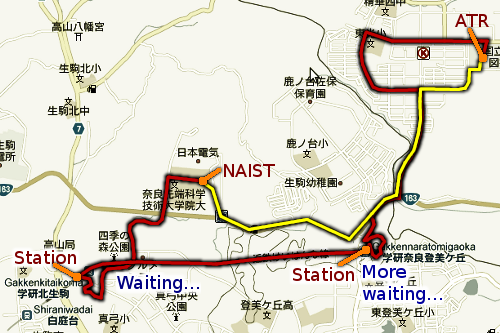
NAIST on the center left, ATR upper right corner. Lower left is Kita Ikoma station, lower right is Gakken-Nara Tomigaoka. The long, red wiggly line is the path taken with train and bus. The short yellow line is by foot. An eagle-eyed observer may suspect that you can actually go straight across, making the distance even shorter; they would be right.
After lunch, with beautiful late summer-like weather (still over 20° here this year) and a stomach full of sushi, I decide it's a good idea to try to walk back, rather than take the train. And I discover that the whole distance takes all of 45 minutes - almost twenty minutes faster than taking the bus and train. That's the yellow line. In fact, the most inconvenient part, from NAIST to Gakken Nara Tomigaoka station takes only fifteen minutes to walk, the exact same time it takes to walk to Kita Ikoma. Taking the train this one stop is simply a waste of time and 200 yen. This is still a fairly roundabout route; you can go right across if you want, from village to village, and probably shave another ten minutes off that walking time.
I had a nice walk after lunch - so what? What's interesting to me is how wedded I've been to the idea that I have to go by train. When I worked at ATR I always took the train from Osaka, and I of course go to NAIST by train as well. So to me, they are isolated islands in my mental map, with no route between them except this "wormhole" or "gate" that is the train linking them to the rest of my world. ATR is part of Keihanna and Housono village where I lived for a couple of years; it's a fairly large area in my mind, with two separate train stations leading away from it. NAIST is a much smaller and more recent island with the Kita Ikoma station as the only exit.
So even with a map right in front of me I simply never really connected the areas in my mind. The only route I knew was via the train stations, so I've always taken the train without thinking about it. Now that I've walked across they're suddenly no longer separate islands, but one connected area. Of course, it's still an island, separate from Osaka on one hand, and Kyoto on the other since I've never really traveled between those areas either, just magically whisked between them by train.
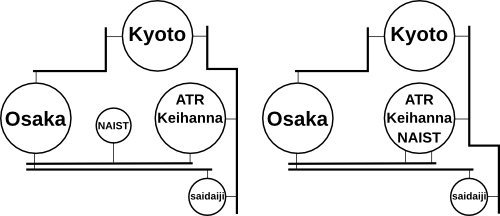
To the left, my map before today's walk; to the right, afterwards. The lines are the "magic portals" - trains - connecting my mental areas. "Osaka" and "Kyoto" are of course really several disconnected maps in their own right. I could probably easily merge "saidaji" with ATR; I've just never had reason to actually go there by foot or bicycle.
One thing I wonder is what kind of transport will alter mental maps like this and what kind will not. Walking can obviously connect and merge areas like it did for me today, and I think bicycles do too. I'm not sure about cars and bikes when you drive; if you're a passenger I strongly suspect you don't.
Being in control rather than a passive observer is probably important (although there's a delightful old experiment by Tolman (I think) where rats wheeled around a maze in a cart do learn the maze without actually running in it). But as important, I suspect, is feedback on the distance you travel. One reason a train doesn't connect areas at all is probably because you get no feedback on how far you're actually going. When you walk or bicycle, you feel the distance directly. With motor transport you don't. In the diagram above I could probably add "Tokyo" right next to Kyoto with a magic line between them, and add "Okinawa", "Helsinki" and "Ho-Chi Minh"-areas via a small, separate "Kansai Airport" blob. They'd all be at the same mental non-distance between each other to me.
I'm sure there must be several studies about this. If I wasn't already buried neck-deep in other papers I need to read I'd go take a look. If anybody already has references about this, though, feel free to send them my way.
First you walk from NAIST to the Kita Ikoma station. Wait for a train and take it (through a tunnel) to the next station over, Gakken-Nara Tomigaoka. From there you either walk or take a bus for Keihanna that leaves every half hour; they're not synced with the trains so you may or may not have to wait for quite a while. Half the buses go fairly direct, half take a scenic detour through the suburbs. All in all the trip takes a bit more than an hour. That's the red line in the map below.

NAIST on the center left, ATR upper right corner. Lower left is Kita Ikoma station, lower right is Gakken-Nara Tomigaoka. The long, red wiggly line is the path taken with train and bus. The short yellow line is by foot. An eagle-eyed observer may suspect that you can actually go straight across, making the distance even shorter; they would be right.
After lunch, with beautiful late summer-like weather (still over 20° here this year) and a stomach full of sushi, I decide it's a good idea to try to walk back, rather than take the train. And I discover that the whole distance takes all of 45 minutes - almost twenty minutes faster than taking the bus and train. That's the yellow line. In fact, the most inconvenient part, from NAIST to Gakken Nara Tomigaoka station takes only fifteen minutes to walk, the exact same time it takes to walk to Kita Ikoma. Taking the train this one stop is simply a waste of time and 200 yen. This is still a fairly roundabout route; you can go right across if you want, from village to village, and probably shave another ten minutes off that walking time.
I had a nice walk after lunch - so what? What's interesting to me is how wedded I've been to the idea that I have to go by train. When I worked at ATR I always took the train from Osaka, and I of course go to NAIST by train as well. So to me, they are isolated islands in my mental map, with no route between them except this "wormhole" or "gate" that is the train linking them to the rest of my world. ATR is part of Keihanna and Housono village where I lived for a couple of years; it's a fairly large area in my mind, with two separate train stations leading away from it. NAIST is a much smaller and more recent island with the Kita Ikoma station as the only exit.
So even with a map right in front of me I simply never really connected the areas in my mind. The only route I knew was via the train stations, so I've always taken the train without thinking about it. Now that I've walked across they're suddenly no longer separate islands, but one connected area. Of course, it's still an island, separate from Osaka on one hand, and Kyoto on the other since I've never really traveled between those areas either, just magically whisked between them by train.

To the left, my map before today's walk; to the right, afterwards. The lines are the "magic portals" - trains - connecting my mental areas. "Osaka" and "Kyoto" are of course really several disconnected maps in their own right. I could probably easily merge "saidaji" with ATR; I've just never had reason to actually go there by foot or bicycle.
One thing I wonder is what kind of transport will alter mental maps like this and what kind will not. Walking can obviously connect and merge areas like it did for me today, and I think bicycles do too. I'm not sure about cars and bikes when you drive; if you're a passenger I strongly suspect you don't.
Being in control rather than a passive observer is probably important (although there's a delightful old experiment by Tolman (I think) where rats wheeled around a maze in a cart do learn the maze without actually running in it). But as important, I suspect, is feedback on the distance you travel. One reason a train doesn't connect areas at all is probably because you get no feedback on how far you're actually going. When you walk or bicycle, you feel the distance directly. With motor transport you don't. In the diagram above I could probably add "Tokyo" right next to Kyoto with a magic line between them, and add "Okinawa", "Helsinki" and "Ho-Chi Minh"-areas via a small, separate "Kansai Airport" blob. They'd all be at the same mental non-distance between each other to me.
I'm sure there must be several studies about this. If I wasn't already buried neck-deep in other papers I need to read I'd go take a look. If anybody already has references about this, though, feel free to send them my way.
Saturday, November 7, 2009
The Future of the Sports Car
Toyota is leaving Formula 1 racing. BMW has decided to quit next year, Honda left already last year, and Renault is reportedly considering leaving as well. Rally has seen losses of car company teams. Crisis for high-end racing, and it's not surprising during a severe economic recession of course, but there's perhaps more to it than that.
The generation-long rivalry between sports car maker Porsche and mass-market Volkswagen ended recently - and symbolically - with Volkswagen taking over Porsche outright (Ferrari is of course already a subdivision of Fiat). And Honda has stopped building sports cars altogether.
The sports car, the muscle car, the two-seater runabout, is - well, not disappearing, exactly; there's always going to be enthusiasts and car models that cater to them. But the era of the Fast Car is coming to an end.
The sports car has long been a small but serious market segment, important far beyond their sales numbers. They are aspirational cars, something to build your brand and lure people into your showrooms to buy one of your mainstream models. Think of how many teen-age boys have had a beloved poster of some sports car or another, and how many of those ended up getting a car from that same manufacturer when they grew older.
More people than ever have licenses and cars to drive. The car is still a very desirable item. But the nature of car ownership is changing. To more and more young people, a car is no longer a defining symbol of adulthood, and the interest in vehicles as a hobby is waning. Ask any motor club about how the median age of its members have changed over the past generation or so.
Also, the car itself is increasingly being viewed as a pollutant and as the main link still chaining us to the current oil-based economy that is increasingly seen as untenable in the long run. Instead, the cars that capture buyers imagination and grab press headlines are increasingly small and efficient cars, and the future-looking all-electric vehicles. A traditional sports car, with its thirsty engine and flashy looks, seems backwards-looking, a symbol of wastefulness as much as youthful fun. A sports car in your line-up no longer helps sell your ordinary cars; indeed, it may be a net negative.
And of course, with electric vehicles the impression of the car changes. It becomes more of an appliance, like your refrigerator, than a potent lifestyle symbol. A gasoline engine is an amazing Rube Goldberg-esque contraption of mechanical linkages and delicately balanced interactions. It is both very accessible to those who wish to tinker with it, and very temperamental, making it well worth tinkering with.
An all-electric system is different. It's far more even, more predictable and reliable, and any required tuning is done completely through software. Not that there's a huge scope for tuning; electric drive systems come pretty close to your theoretical performance limits right from the start. There's just not much fun in hacking an electric car, and plenty of high-voltage danger for anybody trying. The car hobby - car building and tuning especially - is going to have a hard time adapting to this change.
Spreading lack of interest in muscle cars, the negative brand impression of selling thirsty, wasteful gasoline vehicles, the disproportionate cost of keeping up a high-end small-volume brand, and the lack of proper return on investment on very expensive racing programs - those are the reasons that sports cars are slowly disappearing and car makers are turning away from high-end motor sports. The current recession has just accelerated a change already on the way.
The generation-long rivalry between sports car maker Porsche and mass-market Volkswagen ended recently - and symbolically - with Volkswagen taking over Porsche outright (Ferrari is of course already a subdivision of Fiat). And Honda has stopped building sports cars altogether.
The sports car, the muscle car, the two-seater runabout, is - well, not disappearing, exactly; there's always going to be enthusiasts and car models that cater to them. But the era of the Fast Car is coming to an end.
The sports car has long been a small but serious market segment, important far beyond their sales numbers. They are aspirational cars, something to build your brand and lure people into your showrooms to buy one of your mainstream models. Think of how many teen-age boys have had a beloved poster of some sports car or another, and how many of those ended up getting a car from that same manufacturer when they grew older.
More people than ever have licenses and cars to drive. The car is still a very desirable item. But the nature of car ownership is changing. To more and more young people, a car is no longer a defining symbol of adulthood, and the interest in vehicles as a hobby is waning. Ask any motor club about how the median age of its members have changed over the past generation or so.
Also, the car itself is increasingly being viewed as a pollutant and as the main link still chaining us to the current oil-based economy that is increasingly seen as untenable in the long run. Instead, the cars that capture buyers imagination and grab press headlines are increasingly small and efficient cars, and the future-looking all-electric vehicles. A traditional sports car, with its thirsty engine and flashy looks, seems backwards-looking, a symbol of wastefulness as much as youthful fun. A sports car in your line-up no longer helps sell your ordinary cars; indeed, it may be a net negative.
And of course, with electric vehicles the impression of the car changes. It becomes more of an appliance, like your refrigerator, than a potent lifestyle symbol. A gasoline engine is an amazing Rube Goldberg-esque contraption of mechanical linkages and delicately balanced interactions. It is both very accessible to those who wish to tinker with it, and very temperamental, making it well worth tinkering with.
An all-electric system is different. It's far more even, more predictable and reliable, and any required tuning is done completely through software. Not that there's a huge scope for tuning; electric drive systems come pretty close to your theoretical performance limits right from the start. There's just not much fun in hacking an electric car, and plenty of high-voltage danger for anybody trying. The car hobby - car building and tuning especially - is going to have a hard time adapting to this change.
Spreading lack of interest in muscle cars, the negative brand impression of selling thirsty, wasteful gasoline vehicles, the disproportionate cost of keeping up a high-end small-volume brand, and the lack of proper return on investment on very expensive racing programs - those are the reasons that sports cars are slowly disappearing and car makers are turning away from high-end motor sports. The current recession has just accelerated a change already on the way.
Wednesday, November 4, 2009
Elephant Time, Mouse Time
In my copious spare time1 I'm reading another book after finally getting through "The devotion of suspect X"2. This time I'm not doing a novel, but a non-fiction popular science book. It's a good change of pace, and as a bonus I get to practice some useful vocabulary you don't encounter in most fiction or news reporting.
The book is "ゾウの時間ネズミの時間ーサイズの生物学" ("Elephant time, Mouse time - the biology of size") by Tatsuo Motogawa. It's a look at how body size affects various aspects of animal life. The title itself suggests the overall theme: An elephant and a mouse have very different life spans, but their lives scale with size. A mouse has a much faster generation time, it moves and reacts much faster than an elephant - it must look hopelessly slow and ponderous to a mouse - and even their internal organs work faster. The mouse may end up doing as much as the elephant throughout its life so they live "as long", subjectively, even though the life span is very different.
The book is "ゾウの時間ネズミの時間ーサイズの生物学" ("Elephant time, Mouse time - the biology of size") by Tatsuo Motogawa. It's a look at how body size affects various aspects of animal life. The title itself suggests the overall theme: An elephant and a mouse have very different life spans, but their lives scale with size. A mouse has a much faster generation time, it moves and reacts much faster than an elephant - it must look hopelessly slow and ponderous to a mouse - and even their internal organs work faster. The mouse may end up doing as much as the elephant throughout its life so they live "as long", subjectively, even though the life span is very different.
There's chapters on energy use and food intake, how the size of prey versus size of predator, movement range and population density, cellular activity, speed, organ size and so forth. The book is not just about mammals either; it covers related differences between warm-blooded animals, insects, unicellular animals and water life versus land life as well.
At about 230 pages including appendices it's not a big, heavy book. I've read about a fourth of it so far and I find it both enjoyable and very accessible. There's a bit of specialized vocabulary of course (I'd find it disappointing if there weren't) but his style is clear and direct so it's not a problem. The math is minimal, and what there is, is clearly explained and presented. The appendices give more background for those who need or enjoy such things.
If there's one thing I find a bit annoying it's his occasional tendency to insert largely irrelevant observations on Japan in the text. This is something a fair number of Japanese writers seem to do, though; there's even a thriving publishing genre comparing Japan to other countries, always either doom-and-gloom negative or fiercely patriotically positive.
A less scrupulous blogger would probably spin long involved yarns about how this preoccupation reflects on the Japanese society and its insecurities (and so falling prey to the exact same phenomenon they try to analyze). Me, I don't think this is exceptional at all. Everybody loves to hear about themselves, and it's just the form of self-affirmation that differs. The simplistic "We're Special so We're #1!", "We're Special so We're Doomed!"-format is just one that resonates with part of the Japanese public. It's simply akin to when other people slap their flag on every available flat space, or obsessively compare athletic, technical or historical accomplishments with other countries.
These distracting detours aside - and in truth there aren't many of them - it is a fun book; engaging and inspiring enough that it makes me wish I'd studied ecology as a student. It doesn't seem to have been translated, but if you do know Japanese - or if you study it - you can certainly do much worse than to pick this one up at your local book store.
As an aside, this was published in the 中公新書 (chūkōshincho) book series. There's several series of small, inexpensive pocket books here that are either reprinting older works or publishing narrow-interest books like this one in various fields. This series seem to publish a lot of popular academic (science and the arts) and technical works. I've also bought - but not yet read - a biography on Euler, a work on insect neuroanatomy and a book by a retired JR train driver on the design and operation of railways3. They all seem very promising, so I'm not wanting for reading material once I finish this one.
--
#1 My blessed half-hour of peace and solitude on the morning train. The evening ride is for studying Japanese.
Seriously, even ignoring the money - just the parking fees at home and work would almost reach my current monthly train cost - I wouldn't want to commute by car. This free time is too important to waste on driving.
Seriously, even ignoring the money - just the parking fees at home and work would almost reach my current monthly train cost - I wouldn't want to commute by car. This free time is too important to waste on driving.
#2 I know I wasn't very favourably impressed with it. But it turns out it may not completely be the books' own fault. I read it after finishing Reason by Miyuki Miyabe. Ritsuko is also reading another book now, after she finished a Miyabe book series, and she, too, finds that wanting, even though it's a book she should like. It may simply be that Miyabes works are so good that whatever you read afterwards becomes a let-down by comparison.
#3 Why yes, I am a geek. How did you guess?
Sunday, November 1, 2009
November
It's the morning of November 1st. And outside it is, at this moment, 24 degrees.

Current value and today's curve in red, yesterday in orange. one-week averages for this week and this week last year in blue.
The winter may be wet and miserable in Osaka, but at least it's never long. This kind of summer-like weather in November is pretty rare even here though. Better go out and make use of it while we can. Of course, right now "go out and make use of it" for me mainly means reading papers in a café rather than at home, but at least it's something.

Current value and today's curve in red, yesterday in orange. one-week averages for this week and this week last year in blue.
The winter may be wet and miserable in Osaka, but at least it's never long. This kind of summer-like weather in November is pretty rare even here though. Better go out and make use of it while we can. Of course, right now "go out and make use of it" for me mainly means reading papers in a café rather than at home, but at least it's something.
Subscribe to:
Posts (Atom)


